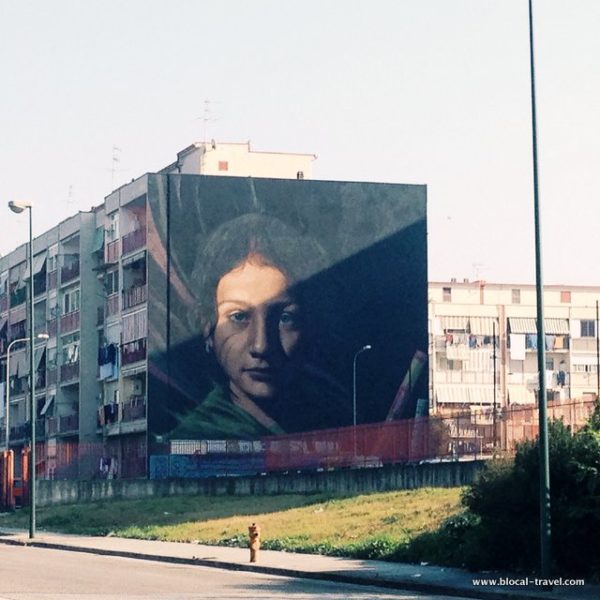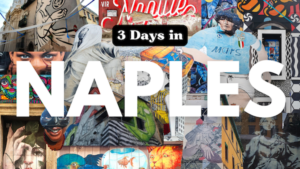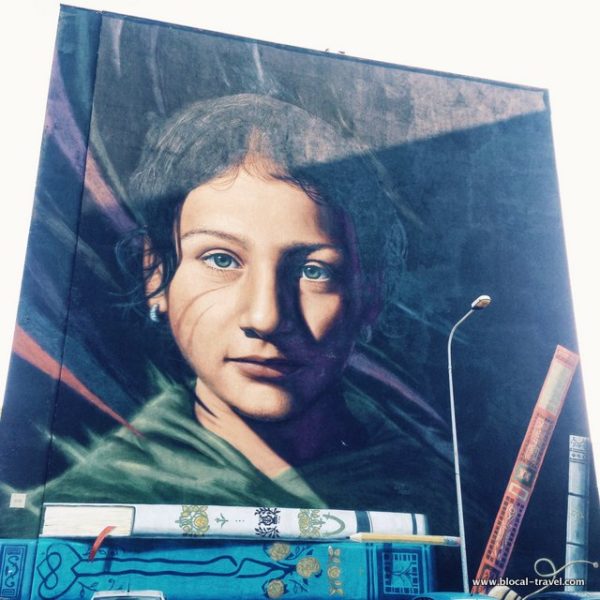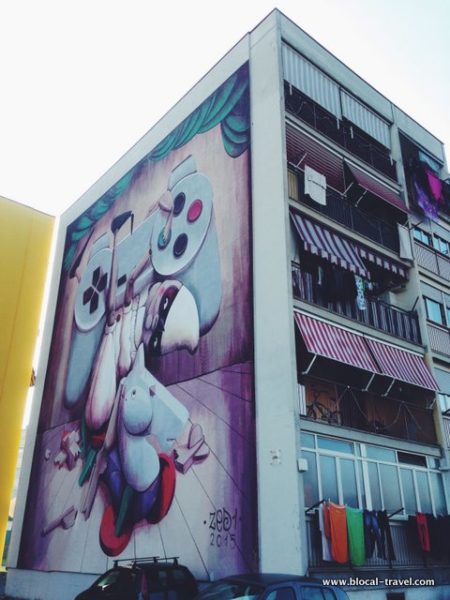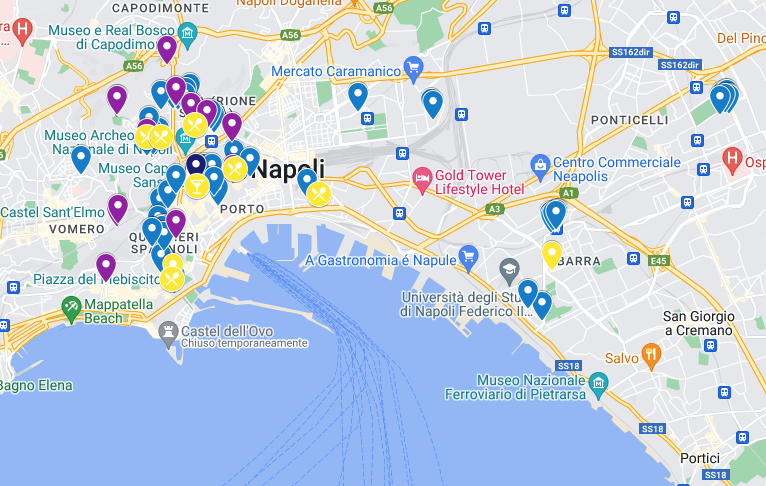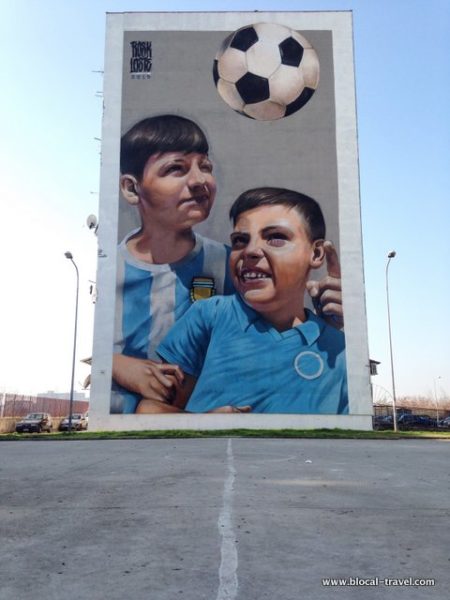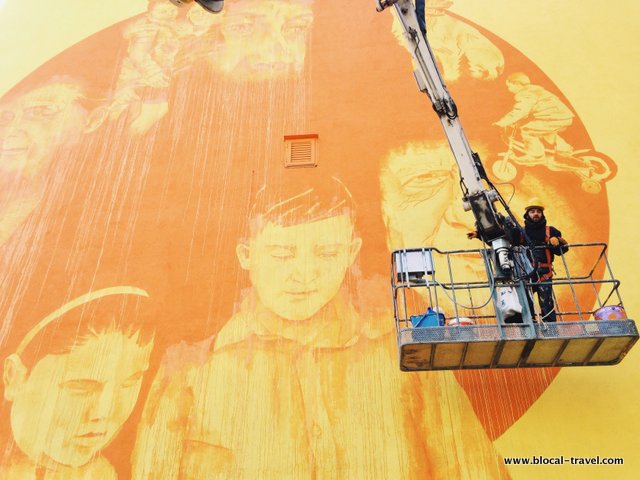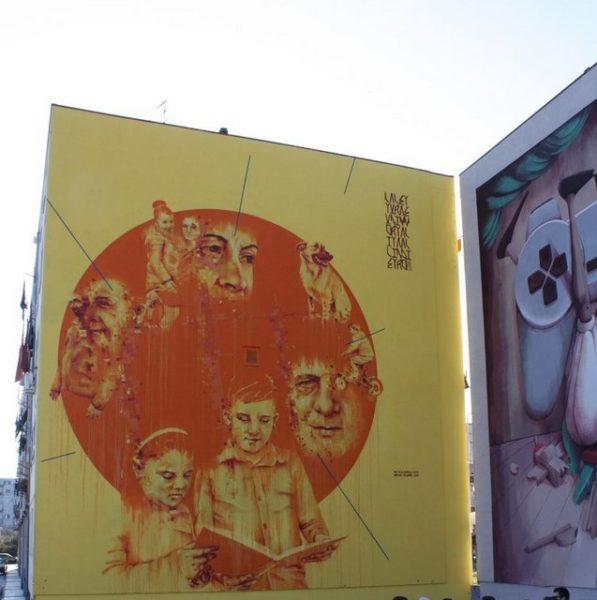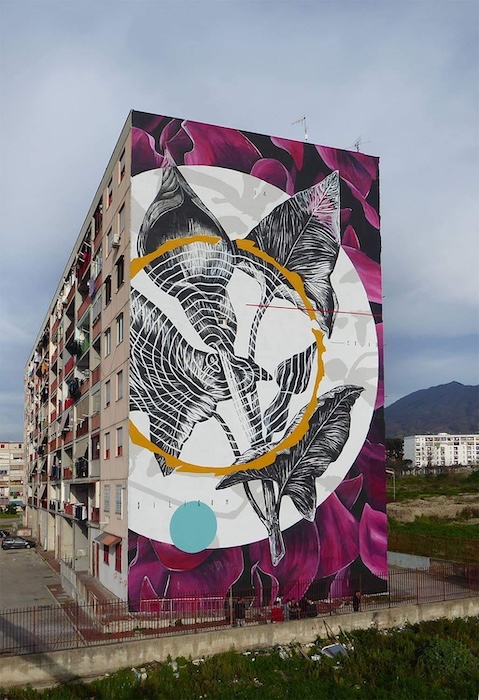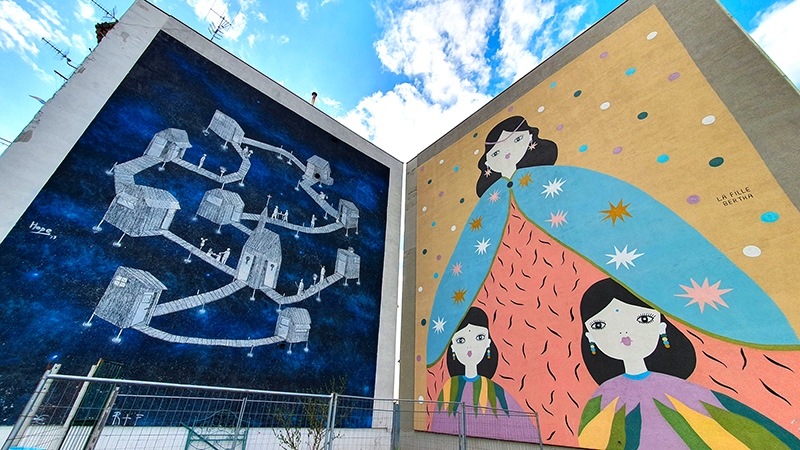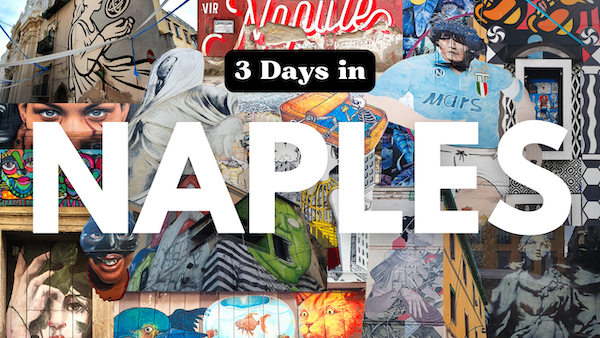A picture is worth a thousand words but, in this case, a picture is not enough. To get the full potential of this street art project organized by Inward you must walk around Parco Merola (Ponticelli), a disadvantaged area in the eastern outskirts of Naples. You must step into the decaying courtyard, meet the people living here and see the neglected buildings with your own eyes to understand that everything that has been written about the Neapolitan outskirts isn’t just words in a newspaper, but actual social contexts that, with a thoughtful work based on urban art but also on discussion and understanding, can change.
What I liked about this project is that murals aren’t large-scale reproductions of top-down sketches drawn elsewhere. Street art in Ponticelli isn’t out of context, even if only one of the artists was born in the area. All the artists who took part in this project accepted the challenge of developing their murals in-progress, by listening to the local community, finding inputs in it and opening up to a discussion about their work.
Again, to understand what this creative process meant, you must visit Parco Merola. It isn’t a curatorial board or a community of artists, but a place where no one has ever held a brush or a pencil before, not to mention studied art or attended exhibitions. Moreover, being there I noticed that the artist-at-work, Mattia Campo dall’Orto from Trieste (a town on the northern border of Italy), needed a translator to understand what the local kids, who only speak Neapolitan dialect, were asking. And they were questioning the palette of colours that the artist meant to use to paint the faces, too pale according to a kid with olive skin. That’s the kind of ‘intrusion’ allowed, or rather encouraged, at Parco Merola; that’s the big challenge faced by the street artists, which –eventually- allowed them to deliver street art that works on the local community’s terms and which they are very proud of.
Anyway, enough of my ramblings. Let’s meet Ponticelli’s heroes now!
- Street art in Ponticelli > Jorit “Ael, tutt’egual song’e criature”
- Street art in Ponticelli > ZED1 “A pazziella ‘n man’ e criature”
- Naples Street Art Map:
- Street art in Ponticelli > Rosk and Loste “Chi è vuluto bene, nun so scorda”
- Street art in Ponticelli > Mattia Campo dall’Orto "Lo trattenimento de' peccerille"
- Updates on the Stunning Murals of Ponticelli, Naples
- Street art in Ponticelli > Fabio Petani "O sciore cchiù felice"
- Street Art in Ponticelli > HOPE (left) & La Fille Bertha (right)
- Naples Street Art Map:
Do you wanna explore Ponticelli and the rest of Naples with me?
let’s go!
Join my Naples Street Art Trip, from March 7 to 9!
Street art in Ponticelli > Jorit “Ael, tutt’egual song’e criature”
The first mural painted in Parco Merola is by the renowned street artist Jorit Agoch, the same artist who painted the San Gennaro’sportrait in downtown Naples.
The protagonist of this mural is Ael, a young roma girl that the artist had met in a nearby gypsy camp. When that camp was burnt down, the anti-racism office offered to sponsor this mural to spread an important social message in an area where integration is proving very difficult. At the bottom of the mural there are some books, pointing out that racial integration will be achieved when roma kids can attend schools like any other kid, as it is through culture, learning and mutual understanding that you can get over racism.
On Ael’s right cheek there is the tribal sign marking every countenance painted by Jorit Agoch. After several trips to sub-Saharan Africa, the artist began to stigmatize his subjects with two red lines that look like scars, which refer to ancient African rituals and indicate that the portrayed subject belongs to his ‘human tribe’; a tribe that isn’t based on race, gender or religion, but on those characteristics that make all human beings equal. The realism of Jorit Agoch’s countenances is really impressive and usually the most powerful point of his portraits is the gaze. To me, Agoch’s mural paintings always recall Stephen McCurry’s photographic art.
- Read also: All About Jorit’s Murals in Naples
While we were admiring Agoch’s street art, a fruit-and-vegetables van entered Parco Merola and drove around it several times, listing all available products through the loudspeaker. ‘This place is so isolated that sellers come right into it” my friend explained.
Street art in Ponticelli > ZED1 “A pazziella ‘n man’ e criature”
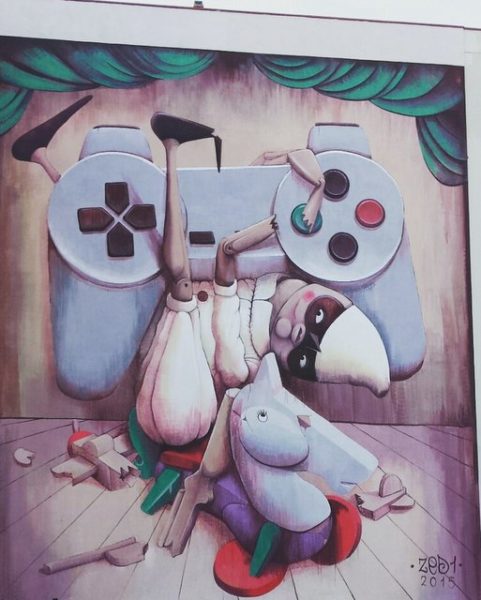
Zed1’s mural is about toys and childhood. To understand why he came up with this theme, let’s go one mural back and look closer at Jorit Agoch’s work. At the bottom, near the books, there is a ‘strummolo’ (a wooden top), which was a popular toy in the past but a stranger to today’s kids to the point that, when he was drawing it on the wall, they kept asking him what it was supposed to be. After further discussions with local kids made it clear that they play mostly with technological games, preferably indoors and on their own, Zed1 decided to paint about modern games vs. traditional toys and mass production vs. craftsmanship. This theme fits perfectly with his on-going personal reflection on human beings and modern society and, looking at this work, I found that he majestically adapted his iconic characters and his sensitivity to the local context.
Zed1’s mural depicts a devilish gamepad crushing the traditional, wooden toys, among which a marionette represented as half ‘Pulcinella’ (the traditional stock character in Neapolitan puppetry) and half ‘Pinocchio’ (the wooden marionette that is the protagonist of a popular children’s novel, whose author, like Zed1, is from Tuscany). The curtain at the top of the mural aims at ‘staging’ the scene, as if to say ‘this is happening: here and now’.
The fruit-and-vegetable van stopped behind us and an old lady lowered her basket from the window. We walked past it and entered the courtyard of Parco Merola, where we found the third mural.
Naples Street Art Map:
Find these murals, and many more, in my street art map of Naples!
Street art in Ponticelli > Rosk and Loste “Chi è vuluto bene, nun so scorda”
Still game-themed, this mural invites children to play with friends in the open air. It also served to push the local municipality to undertake some renovation works in the courtyard to give to the local kids a safer football pitch to play on. The concept behind this mural –in fact- is the importance of taking care of the place where you live, which will educate the next generations to do the same. It was my first ‘encounter’ with these two very talented street artists from Sicily (Rosk and Loste) and it definitely was love at first sight. Their realism is impressive, especially the three-dimensional effect, which plays with the peculiar way in which the sunlight moves across the courtyard during the day. The mural depicts two kids with a ball. One kid is wearing the t-shirt of the Neapolitan team, while the other is wearing the t-shirt of Argentina, as yet another tribute to Maradona (the guy is really worshipped in Naples, btw).
While we were admiring this mural, a kid approached us and warmly hugged my friend and guide-for-the-day. I introduced myself but he was too shy to answer, or to look into my eyes. On tiptoe, he whispered something into my friend’s ear. ‘I’m glad to know that Santa gave you what you had asked for’ she replied; the kid gave her a big smile and, suddenly, ran away towards the last mural of our tour, where his peers had already gathered and were discussing some ‘artistic matters’ with the street artist currently at work.
Street art in Ponticelli > Mattia Campo dall’Orto “Lo trattenimento de’ peccerille”
When I visited Parco Merola this mural was still ‘under painting’, but I already could spot Mattia Campo dall’Orto’s majestic style. Drawing on his on-going artistic research about memory and identity, Mattia developed the theme of storytelling and the importance of reading a story together. Sharing the dreamscapes of a story, like the shared memories of a community, binds people together and make us feel less lonely. What I like about Mattia’s portraits is that they go from realistic to distorted, due to the ‘pixel’ effect that he uses to deform his countenances.
I asked my friend to send me a picture of Mattia’s mural when completed and here it is:
While I was introducing myself to the artist and mumbling compliments about his work in progress, someone yelled to us from behind the fences surrounding Parco Merola. That’s how I met Michele, a guy who was in Ponticelli to visit his family during the Christmas holidays and was now about to drive back to Milan, where he currently lives. Michele confessed to us that, while he was driving past Parco Merola, he was intrigued by Mattia’s mural and couldn’t help stopping the car and coming closer to see what was going on. We talked about street art, gentrification, Milan vs. Naples and Naples vs. its own outskirts, Camorra, new generations, expectations and opportunities for someone growing up in this kind of area (which, usually, means getting away, as Michele did).
Eventually, he realized that he could drive into the area and so we carried on our enthusiastic conversation without a fence between us. While my friend was showing the project to Michele, I had the chance to enjoy a second street art tour of Parco Merola, and even after that I couldn’t get enough!
Moreover, during this second round, I finally discovered what that cute local kid had asked for for Christmas: a box of colourful crayons.
Updates on the Stunning Murals of Ponticelli, Naples
As the saying goes, good things come in threes. In 2023, I returned to Ponticelli for my third street art tour and was greeted by some new murals: a stunning piece by Fabio Petani and two neighboring works, beautifully connected in dialogue, by Hope and La Fille Bertha.
Street art in Ponticelli > Fabio Petani “O sciore cchiù felice”
Fabio Petani’s mural in Ponticelli, titled ‘O sciore cchiù felice (The Happiest Flower), is a vibrant celebration of community and nature, inspired by the creative work of children from the Parco Merola neighborhood. After visiting the greenhouses of the Botanical Garden on Via Foria, the children produced imaginative drawings and photographs that helped shape the mural’s design. Dedicated to Aldo Merola, a renowned botanist and former director of Naples’ Botanical Garden, the artwork highlights the importance of understanding and valuing local heritage. (both the residential complex and the boulevard surrounding the park bear Merola’s name in tribute).
The focal point of the mural is the gigaro chiaro (Arum italicum), a Mediterranean plant native to the Vallone di San Gennaro, which blooms in March—the same month the mural was begun. In ancient folklore, the Italian Arum was believed to possess magical, protective powers, capable of warding off evil spirits. It was placed in cradles to protect newborns and was thought to bring love to those unlucky in romance. The mural’s title, inspired by a song by Almamegretta, serves as a call to action, inviting viewers to reconnect with their roots through knowledge. The “happiest flower” becomes a metaphor for flourishing where one finds nourishment, joy, and growth.
Petani’s mural also carries a deeper reflection on Ponticelli’s transformation. Once home to thriving farmland, much of the area was repurposed for residential development, leading to a loss of public green spaces. This shift became particularly evident after the devastating earthquake of 1980, which prompted a surge in urban construction. True to Petani’s signature style, the mural blends botanical imagery with geometric forms and industrial elements, creating a harmonious dialogue between art, nature, and architecture. Through this fusion, Petani weaves a narrative that connects the mural’s materials and themes to its surroundings, offering a thoughtful exploration of the bond between creativity and environment.
Street Art in Ponticelli > HOPE (left) & La Fille Bertha (right)
La Fille Bertha’s mural, ‘A Mamm’ ‘e Tutt’ ‘e Mamm’ (The Mother of All Mothers – the mural on the right), is a vibrant celebration of motherhood. It depicts a maternal figure sheltering two children beneath her expansive cloak, a contemporary reinterpretation of the Renaissance “Madonna della Misericordia.” The artwork emphasizes motherhood as a gift and calls for integrated support systems for women, particularly in socially and economically vulnerable contexts.
The mural highlights the challenges faced by young mothers, especially in fragile communities where societal norms often frame motherhood as an obligation rather than a choice. It advocates for empowering approaches to parenting and underscores the importance of providing comprehensive support for women navigating the demands of family and work.
The creation process involved the local community through workshops organized by the INWARD team. Activities such as drawing, photography, and reading allowed residents, including children, to share their values, passions, and ideas, which La Fille Bertha seamlessly incorporated into the mural’s design and vibrant color palette.
True to the artist’s Sardinian roots and signature style, the mural features an ethereal female figure floating against a dreamlike, serene background. This surreal aesthetic creates a timeless and universal quality, reinforcing the message of motherhood’s strength and resilience. By blending visual poetry with social commentary, the mural encourages a deeper dialogue about the role and perception of parenting in contemporary society.
On the left, instead, there’s a mural by Daniele Nitti, aka HOPE. Hope’s mural, Je sto vicino a te (I’m Close to You) celebrates solidarity and the power of community. Inspired by workshops with local mothers, teenagers, and children—facilitated by the INWARD team—the mural reflects themes of togetherness, collaboration, and shared well-being.
Set against a starry background, the mural portrays a small, interconnected village symbolizing an ideal community. Figures of all ages—elegantly rendered in Hope’s detailed style—are shown happily engaging in everyday tasks, emphasizing solidarity as the foundation of communal life. The stilted houses, connected by bridges, evoke the waterways of the Sebeto River, which once flowed through eastern Naples before being lost to 20th-century industrial development, tying the mural to Ponticelli’s history and name.
The title, written in Neapolitan dialect, honors Pino Daniele, celebrating the importance of mutual support and neighborly bonds. Hope’s use of constellations adds a surreal, timeless quality, guiding viewers to rediscover authenticity and simplicity. The project also engaged the local community directly, with residents participating in painting their building entrances and distributing flyers to strengthen their connections. Through this collaborative process, the mural becomes both a celebration of and a contribution to Ponticelli’s enduring spirit of solidarity.
Do you wanna explore Ponticelli and the rest of Naples with me?
let’s go!
Join my Naples Street Art Trip, from March 7 to 9!
Naples Street Art Map:
Find these murals, and many more, in my street art map of Naples!
